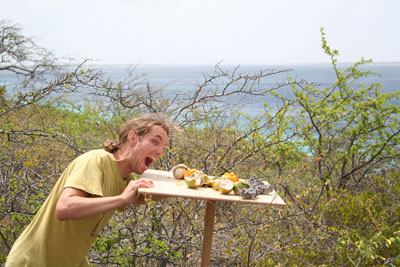The first few weeks in a new place tend to be filled up with sorting out things like transport and where to stay, but I’ve still got into the field and seen the much-missed birds. Amazons are just super cool parrots! They are so feisty and are such characters. Now I remember what joy I get from seeing them out in the wild, flying around in groups and making wonderful bubbly and babbling sounds, they’re FAB! It is amazing though, how a brightly feathered and noisy parrot can suddenly disappear when they land in a treetop.
I’ve visited a number of sites where I expected the parrots would be, and getting a sense of where the parrots are and what they are up to. They move around on the island quite a bit, which is most likely in response to the availability of food, but there are a couple of places where you can usually see at least a few birds. I’ve found a new track that leads up to a stunning viewpoint above some cliffs. There are parrots below and I’m sure they will be nesting in the cliffs later in the year.
One of the aims of my research is to look at the parrot population’s genetics, as historically the population has gone through bottlenecks (a proportion of the population dies, followed by a recovery in numbers). The genetic health of a population can influence the survival of individuals and the ability of the population as a whole to cope with changes to their environment. Global climate change will affect parrots!
To look at the genetics, I have to take blood samples from the birds. While I’m doing that, I will also put leg rings on the birds so individuals can be identified. With marked individuals it becomes possible to look at a huge range of things, such as adult survival, nest site fidelity, movements of individuals and so on, but to do any of this I have to catch parrots! There are various possible ways of doing this, but of course I wish to do it in a way that will cause the least amount of stress for the birds.
The parrots here don’t move around in a predictable or regular fashion, so this is going to be an interesting challenge. I think the easiest approach to begin with will be to get them coming to bird tables with food on them. So there are now a bunch of bird tables around the island and we’ll have to see how all the birds, donkeys, goats and iguanas respond to them.
Picture of me and the bird food table—
how could parrots resist such temping fruit offerings?

Picture of the habitat Wasau

































